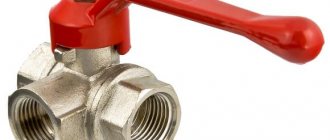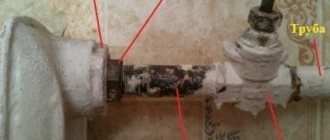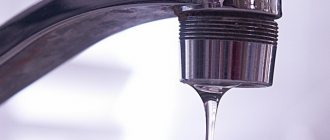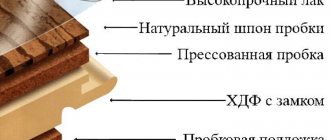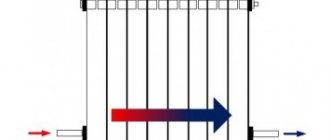03/28/2017 by admin No comments
How does a cone (plug) valve work? Where are these products used? For example, what is the 11B6BK DU50
? How good are such shut-off valve elements in water supply and heating systems compared to alternatives? Let's try to answer these questions.
Our hero.
What it is
Schematic diagram and materials used
This is the name of a locking or regulating device, the main element of which - the plug - has the shape of a full or truncated cone with a through channel and is in contact with the body on all side surfaces. Impermeability to water, air, gas or other media transported by the pipeline is ensured by the absence of a gap between the plug and the walls of the housing.
The design of a plug valve involves a significant friction area and, as a result, a significant force required to turn. Obviously, with a large pipeline diameter it will become unacceptably large; Moreover, sticking of surfaces will additionally increase the resistance.
That is why corrosion-resistant materials with a low coefficient of friction - cast iron and brass - are traditionally used for the manufacture of plug valves.
Please note: due to the design features and low mechanical strength of the metals used, the diameter of plug valves rarely exceeds 100 mm, and the operating pressure is 16 atmospheres.
Before the reader is an assembly drawing of a plug valve.
There are no rules without exceptions: if you wish, you can find a plug-through tap with a diameter of up to 200 millimeters in a steel casing.
However, it has little relation to those valves that can be found in basements:
- To facilitate the rotation of the plug, a gearbox with a steering wheel is used.
- The plug is, after all, made of cast iron: if two steel elements stick to each other, even the gearbox will not help to tear them off.
Housing sealing
How a tap stops the movement of water or gas in a pipeline is not difficult to understand. How is it ensured that there are no leaks to the external environment?
Tension
The plug goes right through the valve body. Its threaded shank, when tightening the nut screwed onto it, presses the plug to the body with considerable force. The absence of a gap guarantees the absence of leaks both through the valve through the pipeline and into the external environment.
Valve with tension seal.
It’s interesting: when the valve operates, the quality of the surface grinding improves over time.
Spring
The gas plug cone valve, which can be seen on the supply line to the gas stove in most Russian apartments, is designed somewhat differently: the plug is pressed to the body not with a nut, but with a spring. A small clamping force, coupled with lubrication, ensures a moderate turning force of the plug; however, the maximum operating pressure of the structure is more than small.
Gas tap.
Stuffing box
Finally, the plug-stuffing valve was widely used for heating and water supply: the stuffing box around the stem ensured the absence of leaks. Typically, a braided graphite seal was used.
How the packing was clamped usually depended on the valve material:
- Brass products used crimping with a union nut.
- A cast-iron plug valve often used a pair of bolts to crimp the gland, which pulled the gland to the body lugs.
Here is an assembly drawing of a cast iron plug valve with a gland secured with bolts.
Methods for connecting the housing to the pipeline
There are actually only two of them:
- Flanged . Adjacent flanges are attracted to each other by four to eight bolts; tightness is ensured by a paronite or rubber gasket.
- Threaded or coupling . For sealing, sanitary flax and artificial sealing materials are used.
Depending on the nominal diameter of the connected pipeline, the DN (nominal size) of the valve is indicated. Domestic documentation uses the metric system; DN approximately corresponds to the internal diameter of the pipeline in millimeters. Imported goods are often marked in inches:
| DU | Size in inches |
| 15 | 1/2 |
| 20 | 3/4 |
| 25 | 1 |
| 32 | 1 1/4 |
| 40 | 1 1/2 |
| 50 | 2 |
Selection of gas valves
If a malfunction is detected in the operation of the gas valve, it is recommended to replace the device as soon as possible. First of all, you need to select a new valve. When choosing, experts recommend considering:
- type of valve;
- basic device parameters.
The gas pipe valve can be:
- cork. The body of the plug valve contains a conical element driven by a flywheel. There is a hole in the conical element (plug), which, when combined with a hole in the pipe, allows gas to flow to the equipment. The seal acts as a sealing material that seals the connection between the faucet and the pipes;
Sectional view of a cork valve
- spherical The design of a ball-type gas valve differs from a plug valve in that the locking mechanism is based on a ball made of durable metal. The ball has a hole, which, when the flywheel is turned, is located along the gas pipeline and in this way passes gas to the consumer.
Gas pipeline valve with ball locking mechanism
According to the method of connection to pipes, a household ball valve can be:
- threaded The valve is connected to the gas pipeline pipes with a threaded connection;
Valve installed with threaded connection
- flanged. The connection to the pipes is made using flanges, which in turn are fixed with bolts;
Gas valve fixed with flanges
- welded, that is, installed using a welding machine.
Gas valve installed by welding
Threaded and flanged valves are reusable, that is, if necessary, you can remove the device from the gas pipe, check its functionality, carry out repairs and install it in its original place. The welded valve can only be installed once.
Basic selection parameters
To select a gas shut-off valve, it is recommended to pay attention to the following factors:
- pipeline diameter. The shut-off element of the valve must completely block the pipe in the apartment. If the valve is larger or smaller, the tightness of the tap will not be complete;
- pitch and diameter of the thread on the pipeline. To quickly replace the device, it is necessary that the specified parameters completely match. Otherwise, you will need to purchase and install additional adapters;
- the material from which the gas pipeline valve is made. It is more advisable to purchase brass taps, as they have a longer service life. You can also find silumin, zinc and plastic taps on sale. You can distinguish the material used to make the valve by weight. Brass faucets are heavier than faucets made from other materials. In addition, you can inspect the place where the thread is cut. Brass has a yellow tint, and all other materials (except plastic) are gray;
Application
Here are a few examples of the use of plug taps in their various designs.
- The most obvious example is the samovar faucet. The plug in it is held in the valve body only by its own weight.
Stopper of the samovar tap.
- Soviet-style faucets with a lever switch were not very convenient to use and often leaked; but they were practically indestructible. Breaking a lever or a plug was not a trivial task.
- Three-way plug valves were used to regulate the temperature in apartments: depending on the position, they allowed the flow of coolant through the radiator, through the jumper, or completely blocked it.
By the way: the last function of the crane was the reason for the fierce hatred of the mechanics who served the microdistricts built up by Khrushchev. It was not immediately possible to find out which of the residents turned off the tap on the riser.
- We have already mentioned Soviet-style gas taps. Compared to the then common screw valves, the plug valve really looked much more reliable and guaranteed no leaks.
- Finally, along with the screw valve, the plug valve was the most common element of shut-off valves for heating and water supply systems in the 60s - 80s of the last century. It was there, in particular, that the 11B6BK DU50 valve mentioned at the beginning of our material was widely used: it was mounted on hot water and heating connections in elevator units.
The photo shows a brass valve 11B6BK DU50.
Gas valve installation
Preparatory stage
To change the gas valve in the kitchen yourself, you need to prepare:
- new tap;
- two gas keys. One wrench is required to unscrew the threads, and the second to hold the down tube stationary. Otherwise, the pipeline leading directly to the gas stove may be damaged;
- means for sealing threaded connections. FUM tape, Tangit Unilok thread or regular linen thread are suitable. When using linen thread, additional treatment of the sealing material with paint is necessary;
Special thread for sealing threaded connections
- graphite lubricant intended for gas valves;
Special composition for gas appliances
- pipe plug. If you replace the valve together, you can do without using a plug.
Replacement process
The gas valve is replaced according to the following scheme:
- the gas supply to the living space is cut off. To do this, the gas valve handle is turned to a position perpendicular to the pipe;
Gas valve in closed position
- the valve is unscrewed from the pipe. If you cannot unscrew the thread, it is recommended to treat the threaded connection with WD-40, which will ensure smooth operation. If a welded valve is installed in the apartment, then it is cut off using a grinder, and threads are cut on the pipes;
- A temporary plug is installed in place of the valve. If the work of replacing the gas valve is carried out by two people, then instead of the plug you can use your partner’s finger. This procedure will facilitate the process of installing a new faucet;
- a sealing thread is screwed onto the thread;
Winding flax thread to make the threaded connection tight
- a layer of graphite lubricant is applied on top of the thread;
Final preparation of threads for valve installation
- A new faucet is being installed.
The process of replacing a gas valve yourself is presented in the video.
Leak test
After installing the gas valve, it is recommended to check the tightness of the device and the resulting connections. For this:
- open the tap and start supplying gas to the stove;
- prepare a saturated soap solution, which is applied to the tap and connection points.
Finding gas leaks using a soap solution
If the device and threads allow gas to pass through, small soap bubbles will form at the leakage site. If a leak is detected, the problem must be corrected quickly.
Doing the job of replacing a gas valve yourself is risky. Any careless action or violation of safety regulations may result in an explosion. Therefore, it is recommended that replacement be carried out by qualified personnel.
Shut-off valves are an essential element of gas pipelines, and they are used for both external pipelines and internal systems. As a rule, a ball gas valve with a diameter of 2 - 1 2 inches is used for domestic gas pipelines.
Below we will take a closer look at the features of these devices and their differences from water taps.
Advantages and disadvantages
How do plug taps compare to alternatives when it comes to plumbing?
Let's start with praise for them.
pros
- Unlike screw valves, they do not need to be oriented in a specific way in the direction of water flow. There is no risk of valve rupture simply due to its absence.
- The straight and wide through channel in the plug creates a fairly moderate hydraulic resistance - again, in contrast to the tortuous passages in a screw valve.
- For the same reason, plug valves never become clogged with scale, sand and rust. There is simply no place for garbage to stay in them.
- Plug valves differ from modern ball valves in their greater resistance to high temperatures.
However: 150 C, the maximum for a ball valve, is the temperature limit on the supply line of the heating main at the peak of winter cold. Higher values are only achievable in steam heating systems, which are currently used only in a few industrial enterprises.
Heating temperature chart. As you can easily see, there are no temperatures above 150C.
Minuses
The author’s experience with plug valves in heating and water supply systems allows us to formulate the following main complaints about them:
- Both cast iron and brass valves boil when left inactive for a long time. To turn them after five years of inactivity requires an effort quite capable of breaking the threads on the drive.
- After the notorious period of inactivity, the slightest turn of the valve leads to water leakage through the seal. Yes, this is a problem - common to all products with stuffing box packing; however, in the case of a screw valve, it is solved by completely opening it. Here you have to refill the oil seal.
- By the way, about the oil seal: you can fill it only by first shutting off and dumping the water. What is the instruction related to? If you open the valve under pressure, the disturbed plug will most likely fly into your face at the front of the water flow. At best it’s cold, at worst it’s scorching hot.
The plug is held in the housing only by the oil seal cover.
For comparison: a valve with lapped cheeks for packing the stuffing box with your own hands is enough to simply close.
- Glandless (tension) valves must be loosened before opening or closing, which is accompanied by water leakage. It is especially touching when you are under the valve. If you do not loosen the tension nut, there is a real chance of tearing the thread off the plug.
- To turn the rod you have to use an adjustable wrench, an open-end wrench, or (most often) a gas wrench. As a result, frequently used taps are easily recognized by their rounded, or even practically absent, stems above the gland.
- With all this, the price of a plug valve is not lower, and often higher, than a ball valve of the same size.
Peculiarities
So, special ball valves have recently been used in gas pipelines. These devices are designed to completely shut off or open the gas flow. The peculiarity of these devices is the locking mechanism, which is made in the form of a ball with a through hole. Moreover, the diameter of the hole coincides with the diameter of the pipeline (see also the article “Where and how is a high-pressure valve used”).
To block the flow, the ball is rotated so that the hole is perpendicular to the pipeline, i.e. it needs to be rotated 90 degrees. The locking mechanism is controlled using a lever. Tightness is ensured by rings made of soft and durable materials.
Differences from plumbing fittings
It must be said that the external difference between a gas tap and a water tap is that the lever is yellow, not red.
There are much more structural differences:
- They have a more durable body, which is made of special types of steel or brass with a high copper content.
- They have a longer connecting thread.
- The locking mechanism is made of particularly durable chrome-plated or nickel-plated material.
- The rod is made of durable polymer material.
- These taps can withstand greater pressure than taps.
- O-rings are stronger and provide a better seal.
Note! Despite the fact that the price of gas taps is higher, they cannot be replaced with water fittings, since the savings can be very expensive. But it is not prohibited to use gas shut-off valves instead of water valves.
In general, the only difference between a gas tap and a water shut-off valve is the increased level of tightness. The remaining points are not so important in domestic gas pipelines. Therefore, in principle, any valve that meets tightness class “A” can be used for a gas pipeline.
How to light a stove without electric ignition?
Repairing electric ignition is a troublesome task; you need to disassemble the stove. Spare parts for the required model, primarily arresters with insulators, are not always on sale, but you need to prepare them. Right now it’s broken, I need to light it, but there are no matches in the house. How to light a gas stove without matches?
It is best to keep a piezo lighter for the stove, with a long spout, just in case. If it’s not there either, use a regular lighter to light a candle and light it. If there is no candle, you need to roll a piece of paper into a tight tube, 5 cm long, set it on fire, and then use the burning piece of paper to use a burner or oven. It smells burnt, but what can you do? Lighting immediately with a cigarette lighter can easily burn your hand.
Oven repair
Repair of a gas stove oven is carried out similarly to the upper burners, but with some features:
- To get to the burner with the jet, you will have to remove the door and bottom panel of the stove.
- To remove the door, it is most often not enough to unscrew the hinge screws; you have to bend the loops slightly and then bend them back.
- Having removed the door, it is advisable to unscrew the screws, remove its inner cover, check the condition of the gaskets (and replace if necessary), remove and wash the protective glass.
- It is permissible to check the operation of the oven burner with the door and bottom panel removed.
Note: When disassembling the door, be careful with the thermometer. If you inadvertently catch its arrow, you can bend the bimetallic spiral, and the device will begin to lie shamelessly.
Features of replacing a gas tap
Sooner or later, any shut-off valve may fail; in particular, gas taps are not immune to failure. If a malfunction of this device is detected, it must be replaced immediately.
It should be said right away that doing this work with your own hands is prohibited! However, you still have to perform some actions yourself.
So, the instructions for replacing this shut-off valve are as follows:
- First of all, you need to report the problem to specialists from the gas service or a private organization that has a license to perform such work.
- Then you need to buy a new faucet from a specialty store. You must first measure the diameter of the pipeline so as not to make a mistake when choosing a product.
- Before the arrival of specialists, you should prepare a technical passport and a gas supply contract. A technical passport is needed to make notes on the work performed.
- Then you need to light the gas on the stove and turn off the central valve. The burner should be left until it goes out completely so that all the gas comes out of the pipeline.
- When specialists arrive, you need to open several windows to create a draft in the room. This is necessary in case of a gas leak.
- After completing the work, you should, together with specialists, check the installed shut-off valves for leaks.
- At the end of the work, you need to provide the service workers with a technical passport and ask them to make a note there.
Advice! You can detect gas leaks using soap foam. It must be applied to the connection points between the device and the pipeline, as well as to the valve itself. If a soap ball forms in some place, it means that the shut-off valve is leaking gas.
After completing the work, you should leave the windows open for another 15-30 minutes, which will ensure complete ventilation of the room.
Types of ball gas valves
In addition to the fact that the shut-off valves in question differ in diameter, the differences lie in the installation method. The following types of devices are most often used in gas pipelines:
| Threaded (coupled) | They have a small diameter. As a rule, these products are used in domestic gas pipelines. The connection to the pipeline, as you might guess from the name, is made using a threaded connection. |
| Flanged | Used in external gas pipelines of large diameter. The connection is made using a flange method using bolts. Like threaded ones, these devices are collapsible, i.e. they can be dismantled and then reinstalled. |
| Welded | Like flanged ones, they are used for external gas pipelines. Their diameter can range from 10 to 70 millimeters. The connection to the pipeline is carried out by welding. Accordingly, this installation option is non-removable. The advantages of such products include complete tightness and high reliability. In addition, welded shut-off valves do not require maintenance, i.e. tightening flange connections. |
Advice! In addition to ball shut-off valves, there are also plug valves. However, they have less reliability and durability, so they have been used very rarely recently.
